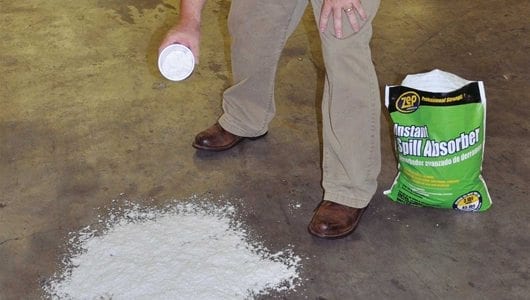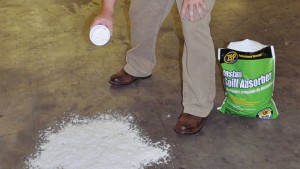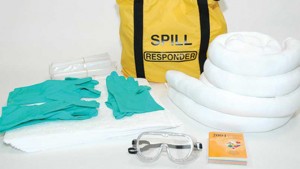
Spill response: How to safely clean up spills

Use a product, such as Zep Instant Spill Absorber, to quickly absorb spilled oils, paint, antifreeze and solvents.
Fuel, lubricants, soil stabilizers, dust palliatives, pesticides, paints, solvents and epoxies are among the many substances that can spill on a jobsite.
Identifying the spill will help determine the level of personal protective equipment (PPE) needed by the responder, the significance of the spill and the materials used to control the spill.
Problem: There’s been a spill
Solution
Assess the risk. Identify the spilled material and determine how much was spilled. What constitutes a significant spill varies according to the substance and the Material Safety Data Sheets (MSDS) for each substance should be used as a guide.
Choose the appropriate personnel protective equipment for the spilled material. If unknown, use the highest level of protection.

Spill kits contain socks, used to confine the spill before it can spread; mats and pillows to soak up spills; and wipers for final cleanup or smaller spills.
Confine the spill quickly; limit the spill area by blocking, diverting or confining the spill using socks, booms, or by digging a dike around the spill.
Stop the source of the leak. This may involve plugging a damaged drum or turning a drum upright. Transfer any liquids from the container to one that is secure.
Evaluate the incident and begin cleanup with the correct spill kit or containment device. As a general guideline, small spills can usually be handled by the first responder without assistance; a semi-significant spill requires assistance from others on the jobsite. A significant spill requires the help of a local emergency response team.
Problem: The wrong spill response can result in an even more dangerous situation.
Solution
Spill containment kits should be designed for the liquid to be contained. Spill kits are designed for oils, coolants, solvents and water; oil-based liquids only, or corrosives and unknown liquids.
Spill kits contain socks, used to confine the spill before it can spread; mats and pillows to soak up spills; and wipers for final cleanup or smaller spills. Acid spills require application of a neutralizer.
Use polyethylene containment devices for corrosive or reactive chemicals, and steel for solvents, fuels and polyethylene-degrading liquids. Flexible containment sumps are a great cost saver.
They keep spills in place and can often allow recovery of the spilled material for reuse.
Problem: How can I be sure there is enough absorbency to contain the spill?
Solution
Determine the volume of liquid that might have to be contained in the event of a spill and keep materials on the jobsite that can handle the worst spills that might occur.
Spill containment pallets, stand-alone sumps capable of supporting one to eight 55-gallon drums, can retain the entire contents of a 55-gallon drum in the event of a failure.
Keep absorbent spill kits out of direct sunlight and hot trailers. UV rays can degrade absorbent mats and the skins of socks. Keep spill kits inside a climate-controlled building or under a tarp to avoid heat-related damage.
Problem: Transferring corrosive materials into smaller containers can result in spills.
Solution
When dispensing or transferring corrosives from one container to another, spills can result. Dispense from only one container at a time and finish dispensing one material before starting to dispense another. Be sure containers are closed tightly after dispensing.
Use a corrosion-resistant drum pump for transferring liquids from a drum into other containers. Do not transfer liquids by pressurizing shipping containers with air or inert gas. Transfer corrosive solids using tools like scoops or shovels that are corrosion-resistant.
Never return unused material to the original container. Traces of contamination may cause a chemical reaction.
Problem: The spill is cleaned up, what do I do now?
Solution
The law requires emergency authorities be notified of any significant spills of any toxic substance, including oil. Failure to report spills as required by local, state and federal guidelines can result in severe penalties. Call 9-1-1 or your local fire department for your state’s emergency response notification number.
There is no substitute for preparation and training when it comes to spill prevention and response. The cost of cleanup, liability costs associated with injury and damage, and fines imposed by regulators can add up to tens or even hundreds of thousands of dollars.
Use a green spill response
Substitute green products for harmful chemicals to lessen your liability for spills, simplify compliance issues and make a positive impact on the environment.
Low VOC paints, non-toxic paint strippers, non-toxic adhesives, and environmentally friendly fertilizers are just some of the many green products available. Always choose the least hazardous materials to do the job effectively and safely, and carry only what you need for a day on your truck.
Spill response dry pesticides
Use a broom and plastic dustpan to sweep up dry chemicals. Place the waste materials into an empty waterproof container or strong garbage bag. Label the container with the name of the pesticide, the PCP Act number, and the approximate amount of pesticide that was spilled.
If the spill occurs directly on soil, dig up and remove the contaminated soil. Cover the area with at least 5 cm of lime. Cover the lime with fresh topsoil. Put the contaminated soil in a strong container, label it and dispose of it according to local regulations.
To clean up pesticides indoors, create a dam around the contaminated area so cleanup does not spread the pesticide. Many pesticide-contaminated areas can be cleaned up with a mixture of household bleach, detergent and water. Use only a little liquid. Cover the clean-up solution with absorbent material and then put the absorbent material into the disposal container with the other contaminated materials.
Inadequate insurance coverage
Many companies don’t realize until too late, that their general liability policy offers little or no protection for spills, due to pollution exclusions written into policies. A Pollution and Remediation Legal Liability (PARLL) policy provides coverage for pre-existing and new pollution conditions, including on-site and off-site clean-up expenses, third-party coverage for on-site and off-site bodily injury and property damage, and legal defense expense coverage.

